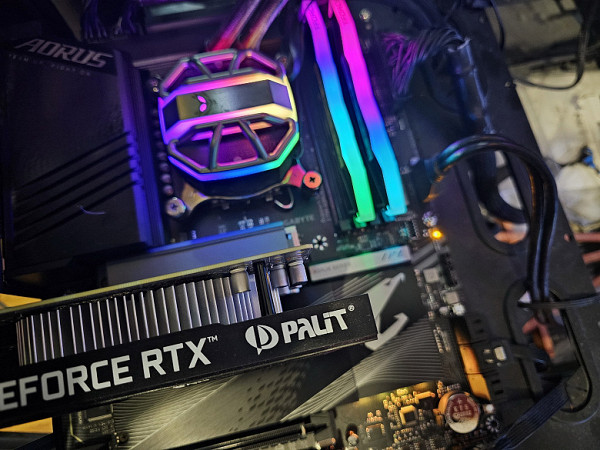The Intel Z790 motherboard, released in 2022, continues to be relevant in the market, and during this time, many models have appeared, offering a variety of features and capabilities. We continue to study these products to understand their features and offerings.
Today's model is interesting because, despite belonging to the premium sub-brand Aorus, it does not belong to the flagship and super-expensive solutions.
Readers may be aware that the Z790 chipset supports 38 high-speed HSIO (High Speed In Out) ports, as well as up to 5 integrated USB 3.2 Gen2x2 ports (up to 20 Gbps), which require support for two USB 3.2 Gen2, either from the Z790 itself or via third-party hubs.
The 12th, 13th and 14th generation processors support PCIe 5.0 with 16 lanes for PCIe x16 slots, as well as 4 PCIe 4.0 lanes for the M.2 slot directly connected to the processor. As for RAM, all three generations of processors are compatible with both DDR5 and DDR4.
Now let's turn our attention to the hero of today's review — the Gigabyte Z790 Aorus Elite AX motherboard.
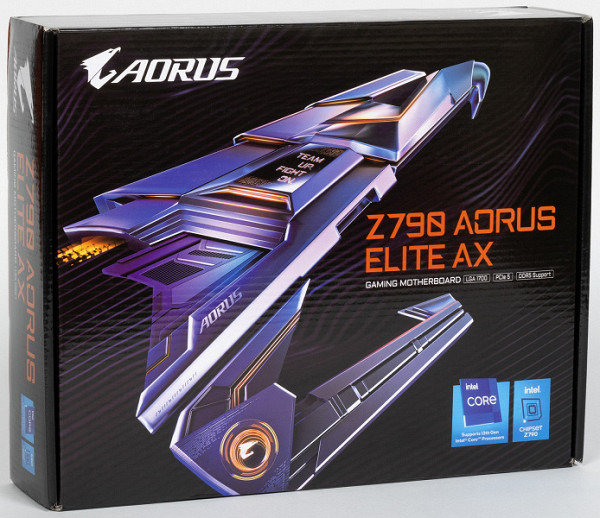
The Gigabyte Z790 Aorus Elite AX motherboard comes in a branded box with a familiar design. All accessories are neatly placed in a separate compartment under the board.
The package is quite modest: in addition to standard items such as a user manual and SATA cables, the kit includes an antenna for the built-in Wi-Fi module and a G-connector, which makes it easier to connect control wires from the case to the motherboard.
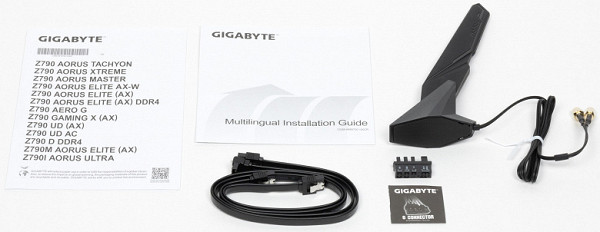
The software is not supplied (the latest versions must be downloaded from the manufacturer's website anyway).
The «plug» for the rear panel with connectors is already mounted on the board itself.
Form factor
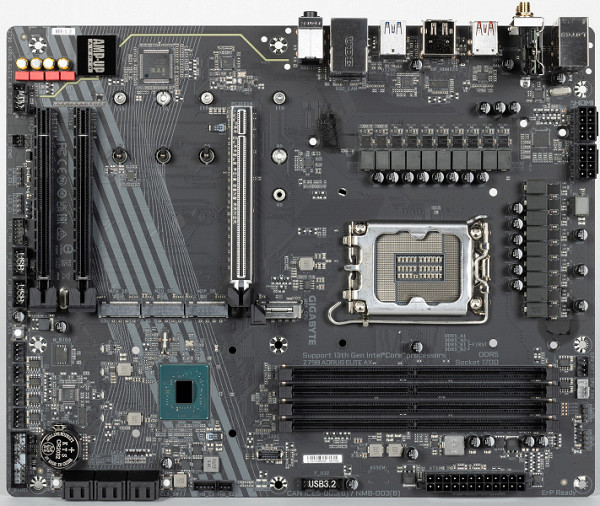
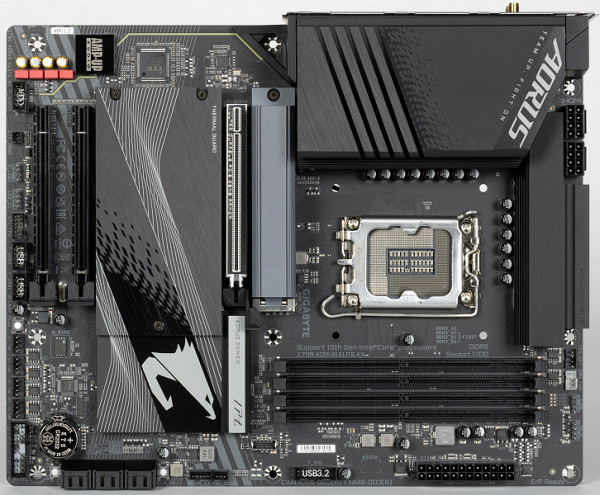
The Gigabyte Z790 Aorus Elite AX motherboard is made in the ATX form factor with dimensions of 305 x 244 mm. It is equipped with 9 mounting holes, which corresponds to the ATX standard and allows you to install the board in appropriate cases. For comparison, the E-ATX form factor can reach dimensions of up to 305 x 330 mm.
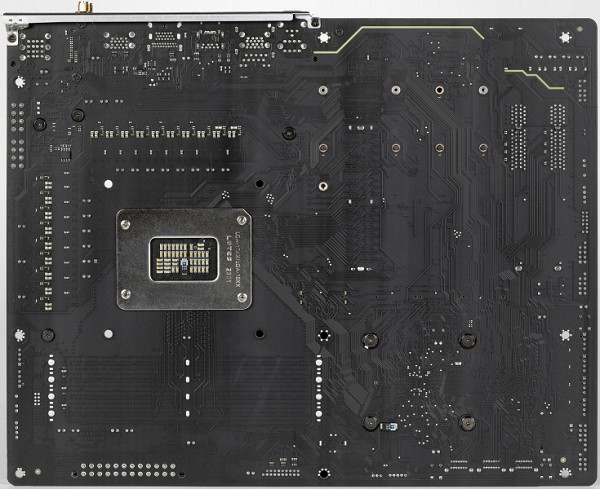
There is practically nothing on the back side. The textolite is processed well: at all soldering points not only sharp ends are cut off, but also everything is well polished. There is no backplate.
Technical specifications
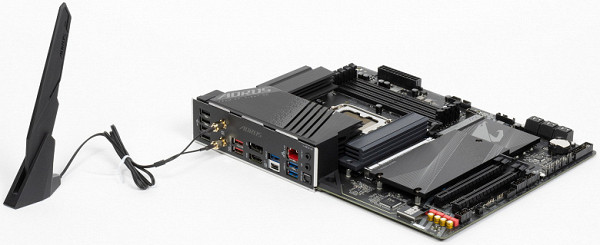
Traditional table with a list of functional features.
| Supported Processors | Intel Core 12/13/14th generation |
|---|---|
| Processor socket | LGA 1700 |
| Chipset | Intel Z790 |
| Memory | 4 × DDR5, up to 7600 MHz (XMP), up to 192 GB, two channels |
| Audio subsystem | 1 × Realtek ALC1220 (5.1) |
| Network controllers | 1 x Realtek RTL8125BG Ethernet 2.5 Gbps 1 x Realtek RTL8852 WiFi 6E (Wi-Fi 802.11a/b/g/n/ac/ax + Bluetooth 5.3) |
| Expansion slots | 1 × PCIe 5.0 x16 (x16 mode) 2 × PCIe 4.0 x16 (x4 mode) |
| Storage connectors | 6×SATA 6Gb/s (Z790) 1×M.2 (M2A_CPU, CPU, PCIe 4.0 x4 for 2280/22110 devices) 1×M.2 (M2Q_SB, Z790, PCIe 4.0 x4 for 2280/22110 devices) 1×M.2 (M2P_SB, Z790, PCIe 4.0 x4 for 2280/22110 devices) 1×M.2 (M2M_SB, Z790, PCIe 4.0 x4/SATA for 2280/22110 devices) |
| USB port | 4×USB 2.0: 2 x 4-port internal connectors (GL850G) 4×USB 2.0: 4 x Type-A ports (GL850G) 2×USB 3.2 Gen1: 1 x 2-port internal connector (Z790) 3×USB 3.2 Gen1: 3 x Type-A ports (Z790) 1×USB 3.2 Gen2: 1 x Type-C internal connector (Z790) 1×USB 3.2 Gen2x2: 1 x Type-C port (Z790) 2×USB 3.2 Gen2: 2 x Type-A ports (Red) (Z790) |
| Rear panel connectors | 1 × USB 3.2 Gen2x2 (Type-C) 2 × USB 3.2 Gen2 (Type-A) 3 × USB 3.2 Gen1 (Type-A) 4 × USB 2.0 (Type-A) 1 × RJ-45 2 x mini-jack audio 1 × S/PDIF (optical, output) 1 × DP 1 × HDMI 2 x antenna connectors |
| Other internal elements | 24-pin ATX power connector 2 8-pin EPS12V power connector 1 M.2 slot (E-key), occupied by a wireless network adapter 1 connector for connecting a USB 3.2 Gen2 Type-C port 1 connector for connecting 2 USB 3.2 Gen1 ports 2 connectors for connecting 4 USB 2.0 ports 6 connectors for connecting 4-pin fans and ZSO pumps 1 connector for connecting a non-addressable RGB strip 3 connectors for connecting an addressable ARGB strip 1 audio connector for the front panel of the case 1 connector for resetting the CMOS 1 connector for TPM security devices 2 connectors for discrete Thunderbolt cards 1 connector for connecting the front panel of the case 1 BIOS flashing button — Q Flash Plus 1 reset button |
| Form factor | ATX (305×244 mm) |
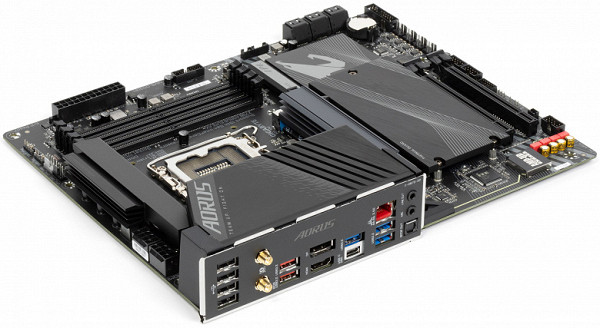
Main functionality: chipset, processor, memory
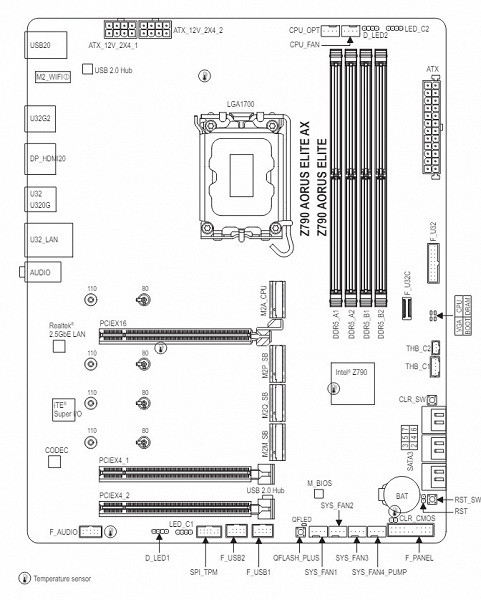
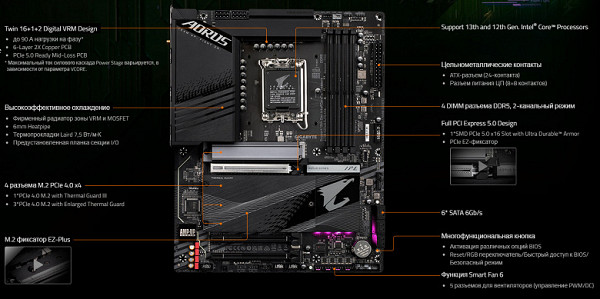
Scheme of operation of the chipset+processor bundle.
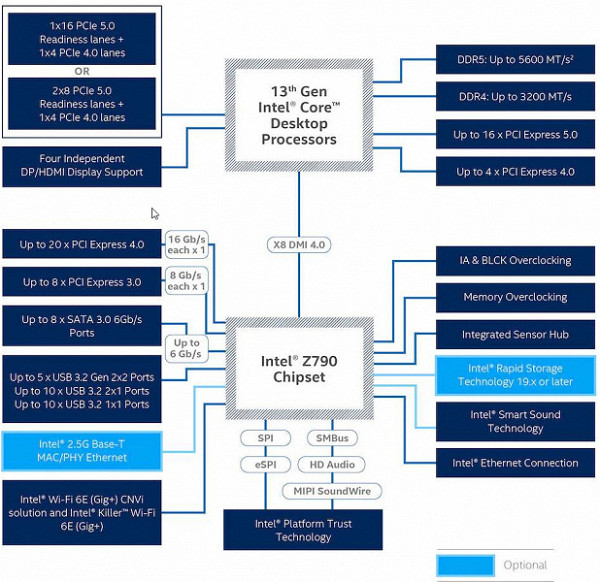
Officially, the motherboard supports DDR5 memory with a frequency of up to 5600 MHz, but in practice, thanks to XMP profiles, you can reach frequencies of up to 7000 MHz and higher. In particular, this model supports frequencies of up to 7600 MHz.
Intel Core processors compatible with the LGA1700 socket and the Z790 chipset have 20 I/O lines: 16 for PCIe 5.0 and 4 for PCIe 4.0, but they do not support USB and SATA ports. Communication with the Z790 chipset is carried out through a special Digital Media Interface 4.0 (DMI 4.0 x8) channel. All PCIe lines from the processor are connected to the PCIe and M.2 expansion slots. The Serial Peripheral Interface (SPI) is used to interact with the UEFI/BIOS system, and the Low Pin Count (LPC) bus is responsible for communication with I/O devices that do not require high bandwidth, such as fan controllers and TPM.
The Z790 chipset, in turn, supports up to 38 I/O lines, which can be distributed as follows:
- up to 14 USB ports (including up to 5 USB 3.2 Gen2x2 ports, 10 USB 3.2 Gen2 ports, up to 10 USB 3.2 Gen1 ports, up to 14 USB 2.0 ports, with USB 2.0 lines also used to support USB 3.2 ports, and each USB 3.2 Gen2x2 port requires support from two USB 3.2 Gen2 ports);
- up to 8 SATA 6 Gbps ports;
- up to 28 PCIe lines (8 version 3.0 and 20 version 4.0).
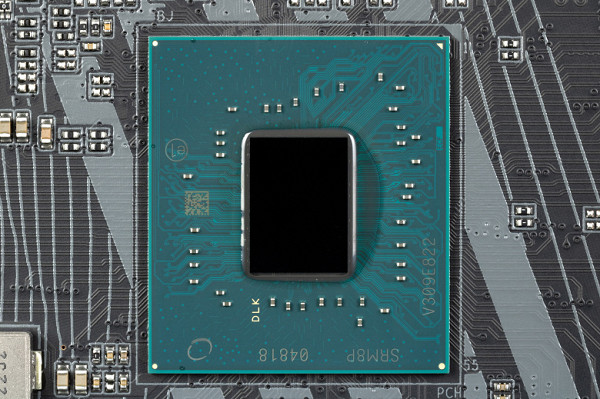
Once again, it is worth reminding that the Gigabyte Z790 Aorus Elite AX supports 12/13/14th generation Intel Core processors made for the LGA1700 socket.
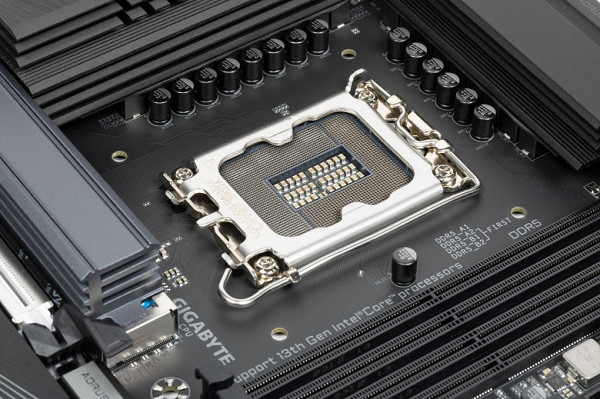
The Gigabyte motherboard has four DIMM slots for installing memory modules. For memory operation in Dual Channel mode when using two modules, it is recommended to install them in slots A2 and B2.
The board supports unbuffered DDR5 memory (without EСC support), with a maximum capacity of up to 192 GB.
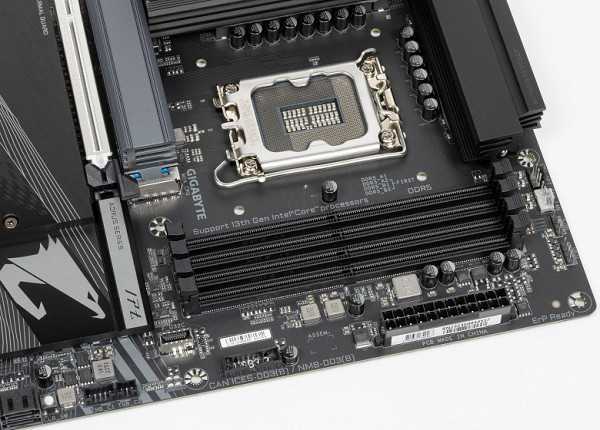
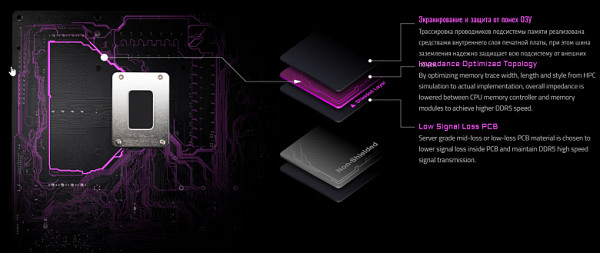
Peripheral functionality: PCIe, SATA, various additional devices
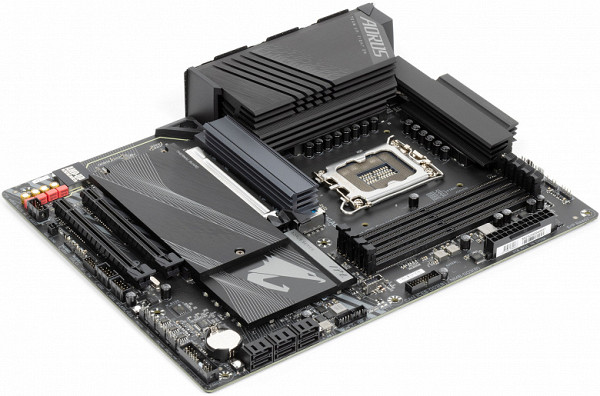
Above we have studied the potential capabilities of the Z790+Core tandem, and now let's see what of this and how it is implemented in this motherboard.
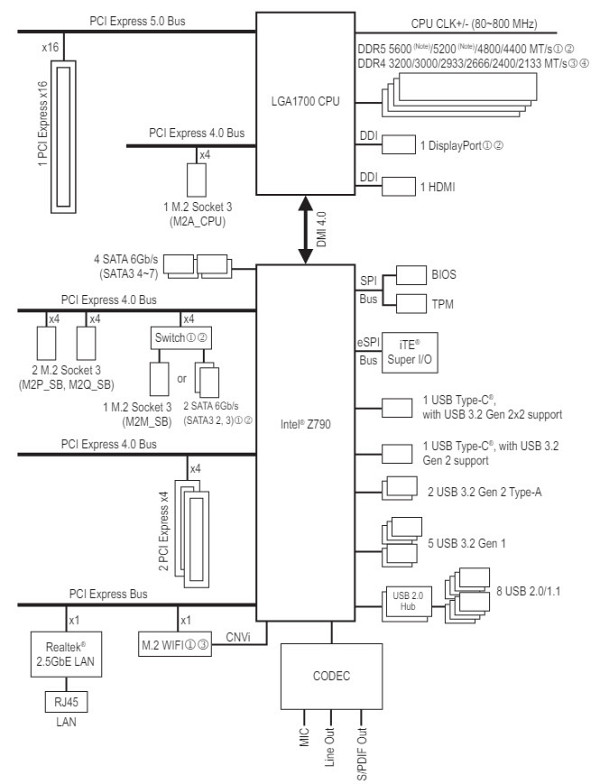
The Z790 chipset has 28 PCIe lanes that are distributed among various components on the board. It is important to note that these lanes are divided into 20 PCIe 4.0 lanes and 8 PCIe 3.0 lanes. Let's look at how they are used:
- The PCIe x16_2 slot takes up 4 PCIe 4.0 lanes.
- The PCIe x16_3 slot also uses 4 PCIe 4.0 lanes.
- The SATA_4/5/6/7 ports require 4 PCIe 3.0 lanes.
- The M.2 (M2Q_SB) slot uses 4 PCIe 4.0 lanes.
- The M.2 (M2P_SB) slot also takes up 4 PCIe 4.0 lanes.
- The switch allows you to choose between the M.2 slot (M2M_SB), which uses 4 PCIe 4.0 lanes, or the SATA_2/3 ports, which require 2 PCIe 4.0 lanes (maximum 4 PCIe 4.0 lanes).
- The Realtek RTL8125BG Ethernet controller (2.5 Gbps) uses 1 PCIe 3.0 lane.
- The Realtek RTL8852 wireless module (Wi-Fi/BT) also requires 1 PCIe 3.0 lane.
Thus, 26 PCIe lanes are occupied (20 PCIe 4.0 + 6 PCIe 3.0). Communication with audio codecs such as Realtek RTL408x is carried out via USB 2.0, and with codecs of the RTL1220 level and below — via HDA (PCI bus emulation), which does not require additional lanes. However, one USB 2.0 lane is used to support Bluetooth, and the 2 GL850G controllers also use USB 2.0 signal lines. We will look at these details in the USB ports section.
Now about the operation of the processors in this configuration. The CPU has a total of 20 PCIe lanes: 4 PCIe 4.0 lanes are allocated to the M.2 slot (M2A_CPU), and the remaining 16 PCIe 5.0 lanes are connected to the PCIe x16_1 slot.
Now let's look at the general operation of the PCIe slots.
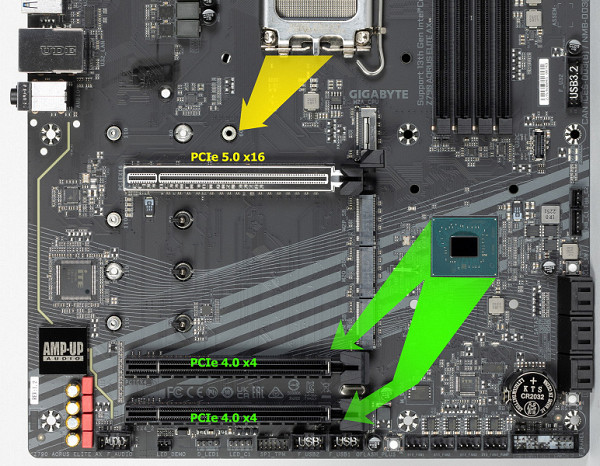
The board has three PCIe slots: one PCIe x16_1 (intended for video cards or other devices) and two PCIe x16_2 and PCIe x16_3 slots, which actually work using 4 PCIe 4.0 lanes each.
As you can see, there is no redistribution of PCIe 5.0 lanes, so there are no PCIe 5.0 multiplexers on the board. Earlier, I mentioned the PCIe x16_1 slot, which is connected directly to the processor. The remaining two PCIe x16 slots are connected to the Z790 chipset and, despite their physical form factor, work in x4 mode.
The first PCIe x16 slot has a reinforced design. It is equipped with a protective frame made of zinc alloy, providing effective protection against electromagnetic interference, as well as rubber inserts that prevent damage to video cards during installation.

For easy removal of video cards from the PCIe x16_1 slot, an extended «tail» on the lock is provided. This greatly simplifies access to the latch for unlocking the card, especially when there is an M.2 slot with a high radiator above the first PCIe slot, which can make it difficult to access the standard latch.
The motherboard allows you to install cooling systems of any size.
Since the board belongs to the mid-price segment, it is not equipped with an external clock generator and signal amplifiers (re-drivers) for PCIe 4.0/5.0.
Now let's move on to considering the drives.

In total, the board has 6 Serial ATA 6 Gbps connectors + 4 slots for M.2 form factor drives. All SATA 2,3,4,5,6,7 ports are implemented via the Z790 chipset and support RAID creation.
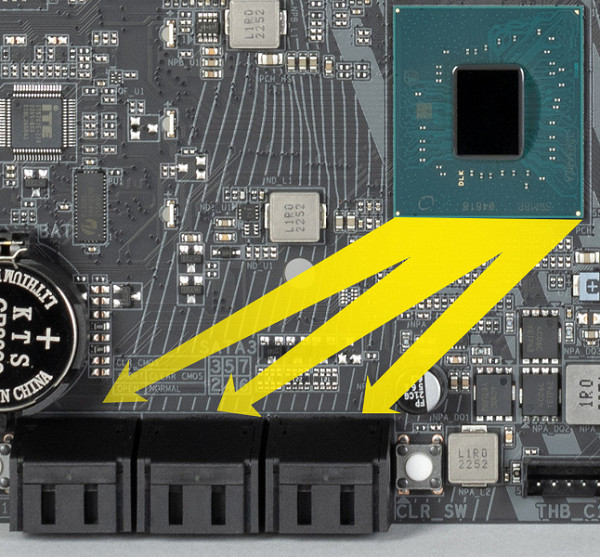
At the same time, 2 SATA 2/3 ports share resources with one of the M.2 slots, so let's move on to the latter.
The motherboard has 4 M.2 form factor sockets.
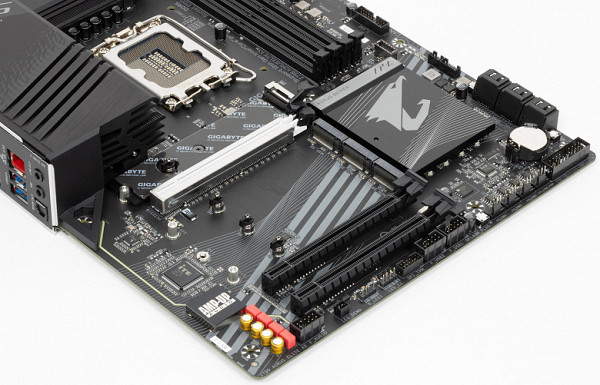
The second, third and fourth M.2 slots (M2Q_SB, M2P_SB, M2M_SB) receive data from the Z790 chipset, while the first M2A_CPU slot is connected directly to the processor and uses PCIe 4.0.
Of all the M.2 slots, only M2M_SB supports modules with any interface, while the others only work with PCIe modules. The M2M_SB slot shares resources with two SATA ports: 2 and 3, for which the motherboard has a multiplexer from Diodes Inc.
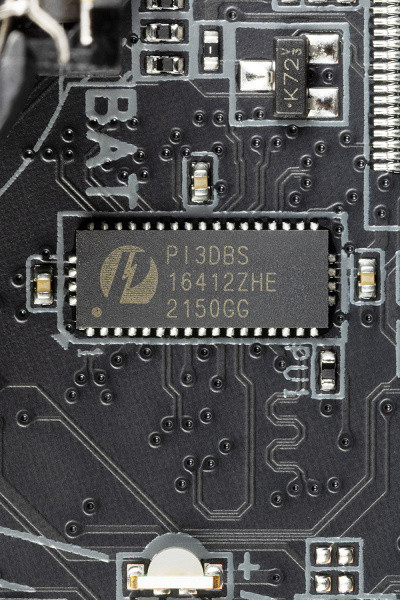
All M.2 slots support 2280 and 22110 size modules, while the M2A_CPU also has mounts for 2260 size modules.
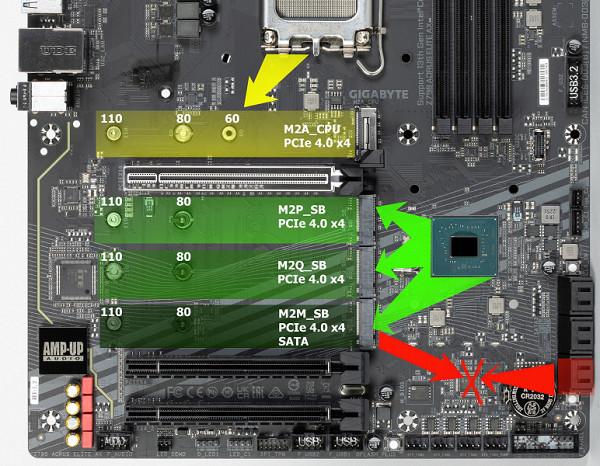
RAID can be configured on all M.2 slots. Particular attention should be paid to the mounting of M.2 drives, which is carried out using twist locks installed on the racks. This method eliminates the need for small screws.
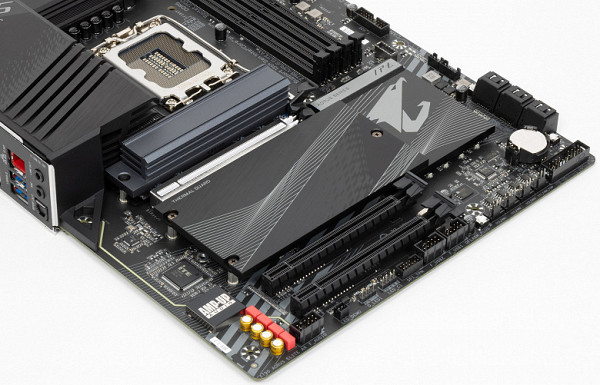
All M.2 slots are equipped with heatsinks. The top M2A_CPU slot has a separate heatsink that is easily installed using latches, without the need for screws. The remaining M.2 slots are covered by a common heatsink.
Peripheral functionality: USB ports, network interfaces, input/output
Now it's the turn of USB ports and other inputs and outputs. And let's start with the back panel, where most of them are located.

So, the Z790 chipset supports up to 14 USB ports, which can include up to 10 USB 3.2 Gen1 ports, up to 10 USB 3.2 Gen2 ports, up to 5 USB 3.2 Gen2x2 ports, and/or up to 14 USB 2.0 ports.
Of the 28 PCIe lanes used to connect storage, network, and other controllers, 26 are already allocated, as described earlier.
In total, the motherboard has 17 USB ports:
- 1 USB 3.2 Gen2x2 port: provided by the Z790 chipset and presented on the rear panel as a Type-C port.
- 3 USB 3.2 Gen2 ports: all supported by the Z790 chipset, of which 2 Type-A ports (colored red) are located on the rear panel, and 1 Type-C port is available internally.
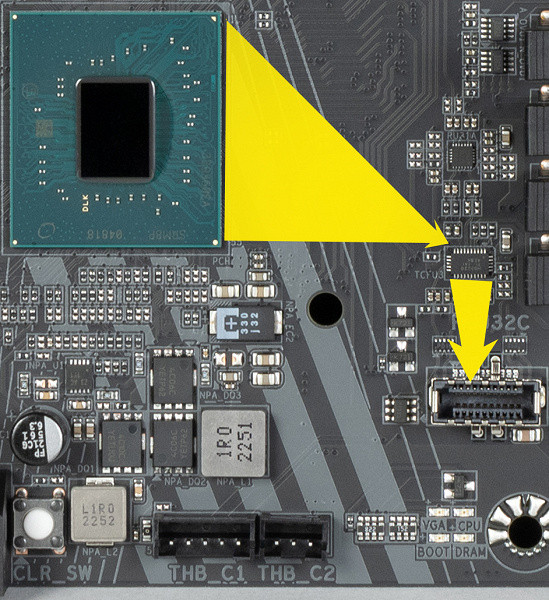
(for connection to the corresponding connector on the front panel of the case);
- 5 USB 3.2 Gen1 ports: all implemented via Z790 and 2 represented by an internal connector on the motherboard
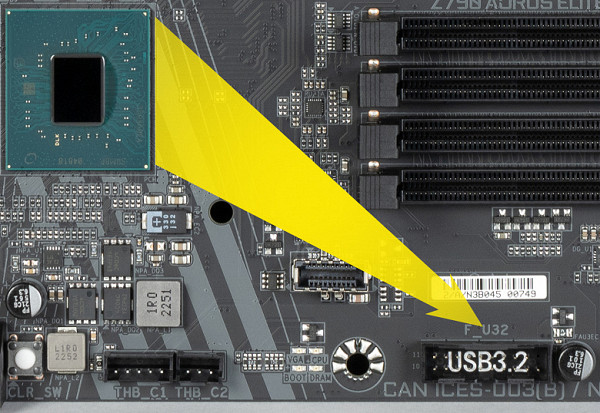
2 ports; 3 more are represented on the rear panel by Type-A ports (blue);
- 8 USB 2.0/1.1 ports: 4 are implemented via the Genesys Logic GL850G controller (1 USB 2.0 line from the Z790 is spent on it) and are represented by two internal connectors
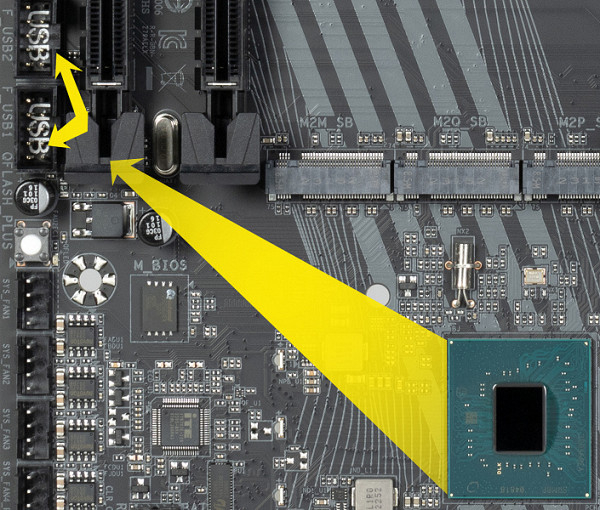
(each with 2 ports); another 4 are implemented via the second Genesys Logic GL850G controller
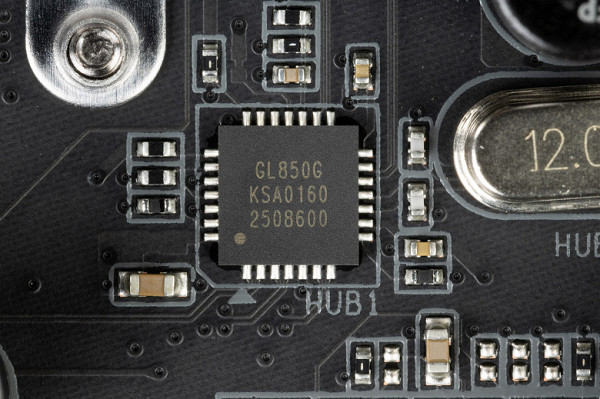
The following controllers are used for USB ports on the motherboard:
- Genesys Logic GL850G (2 internal USB 2.0 connectors) — 1 USB 2.0 lane.
- Genesys Logic GL850G (4 Type-A USB 2.0 ports) — 1 USB 2.0 lane.
- Bluetooth (RTL8852) — 1 USB 2.0 lane.
The Z790 chipset provides the following high-speed USB ports:
- 1 USB 3.2 Gen2x2 port (dedicated, obtained at the expense of other HSIO lanes).
- 3 USB 3.2 Gen2 ports.
- 5 USB 3.2 Gen1 ports.
- 2 USB 3.2 Gen2 ports (to provide USB 3.2 Gen2x2).
So, the Z790 chipset supports 10 high-speed USB ports. Each of these ports also uses a USB 2.0 lane, which means that 10 USB 2.0 ports are already occupied. Additionally, 3 USB 2.0 ports provide controllers. In total, 13 USB ports are implemented.
In addition, the chipset allocates 26 PCIe lanes to support various peripherals.
Thus, out of 38 possible HSIO lanes, the Z790 chipset uses 36 for high-speed ports and peripheral support.
All high-speed USB Type-C ports are equipped with re-drivers that provide stable voltage and fast charging of mobile devices.
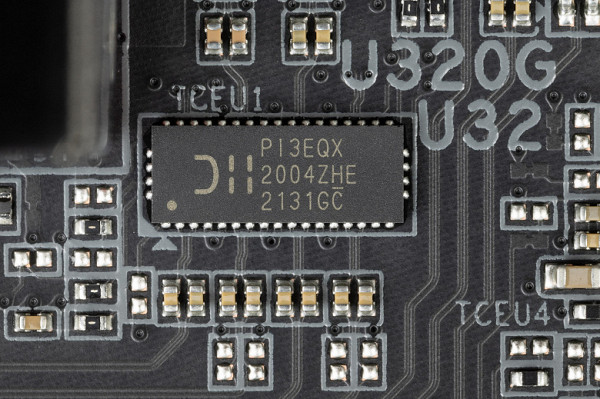
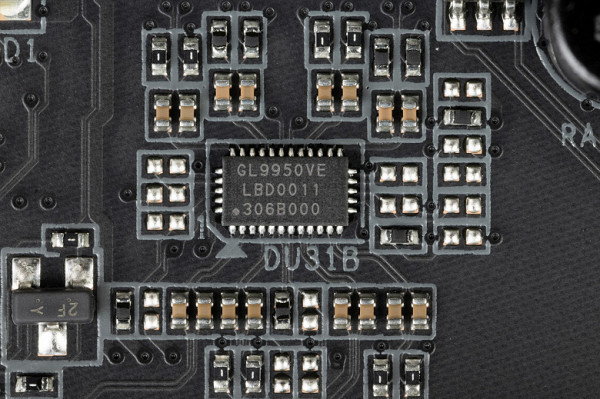
Now about network matters.
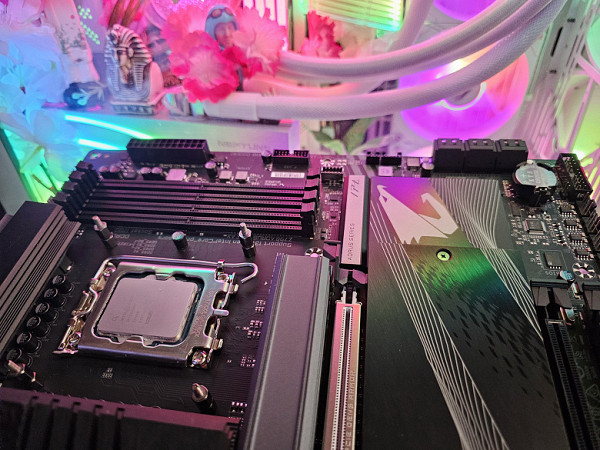
The motherboard is very well equipped with communication tools. There is a high-speed Ethernet controller Realtek RTL8125BG, capable of operating at the 2.5 Gbps standard.
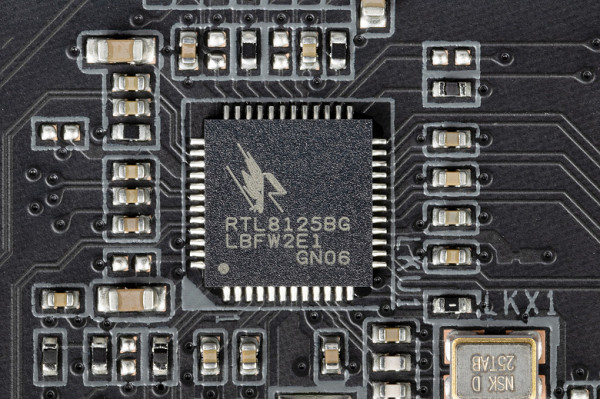
The board has a complex wireless adapter on the Realtek RTL8852 controller, which supports Wi-Fi 6E (802.11a/b/g/n/ac/ax) and Bluetooth 5.3. The adapter is located in the M.2 slot (E-key), and the antenna connectors are located on the rear panel.
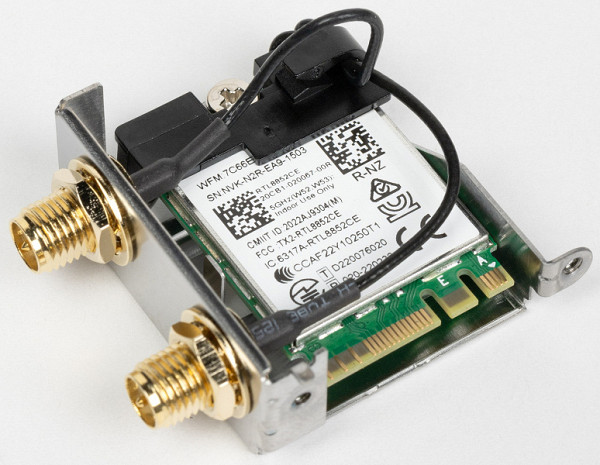
The plug, traditionally placed on the rear panel, is already placed in this case and is shielded from the inside to reduce electromagnetic interference.
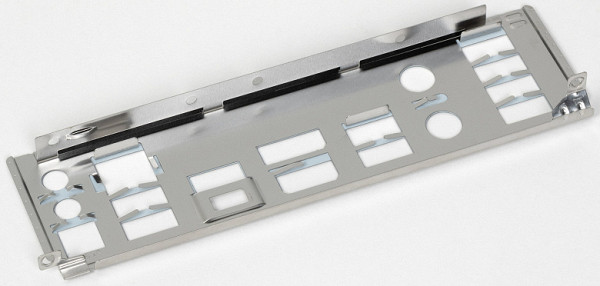
Audio subsystem
Previously, most modern motherboards were controlled by the Realtek ALC1220 audio codec, which provided sound output in formats up to 7.1 with a resolution of up to 24 bits/192 kHz. Although we have already encountered the more advanced ALC4082 with 32 bits/384 kHz, in this case the ALC1220 is used again. At the same time, the sound output circuit is simplified to 5.1 channels. The chip is protected by a metal cover.
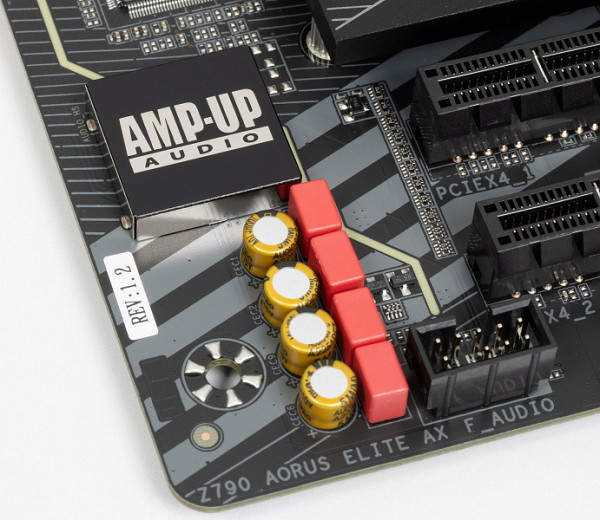
The board's audio circuits use «audiophile» capacitors.
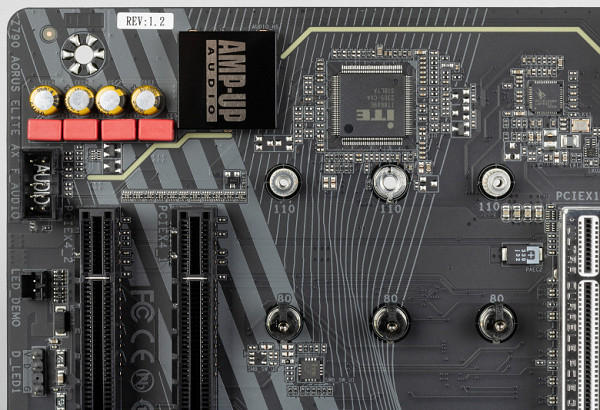
The audio path is located on the corner of the board and does not intersect with other components. For connection, there are two universal connectors with gold-plated coating for receiving and transmitting signals, as well as optical S/PDIF. Sound output in 5.1 format is possible only via S/PDIF, since the analog circuit is limited to stereo.
Power, cooling
To power the board, there are 3 connectors: in addition to the 24-pin ATX (it is on the right side of the board (in the photo — on the left), there are two more 8-pin EPS12V.
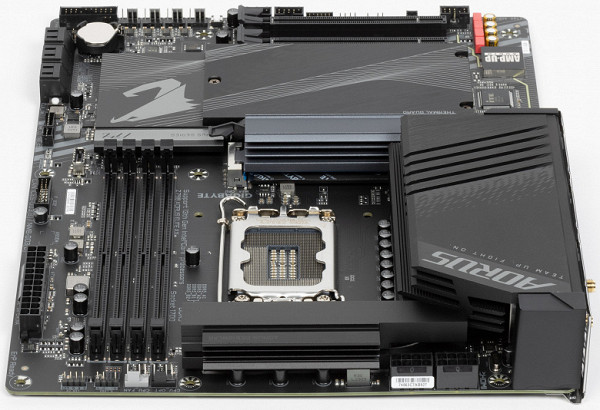
The processor power supply circuit is designed according to the 16+2+1 scheme (a total of 19 phases, 16 on VCore, 2 on VCCIO and 1 on the integrated graphics core).
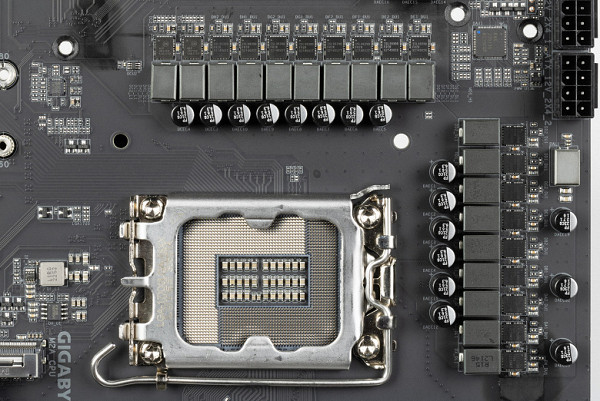
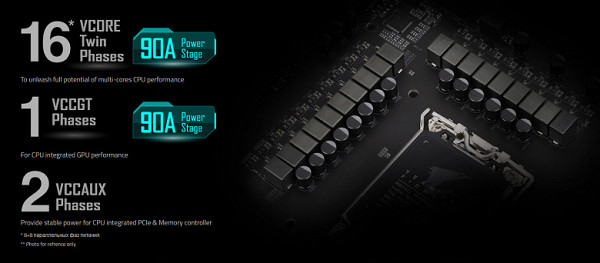
Each VCore phase channel has a superferrite choke and a DrMOS ISL99390 (90A) from Renesas.
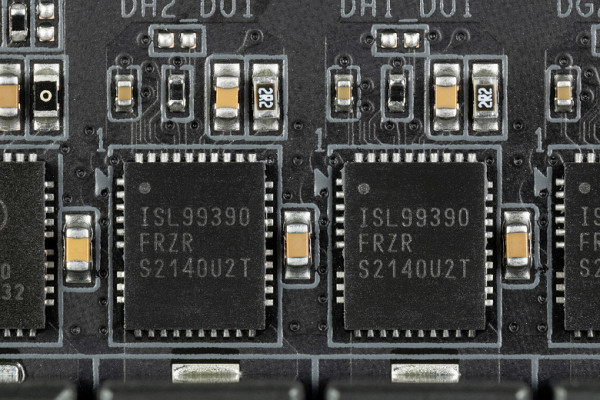
The iGPU phase is equipped with a Renesas ISL99360 (60A) assembly.
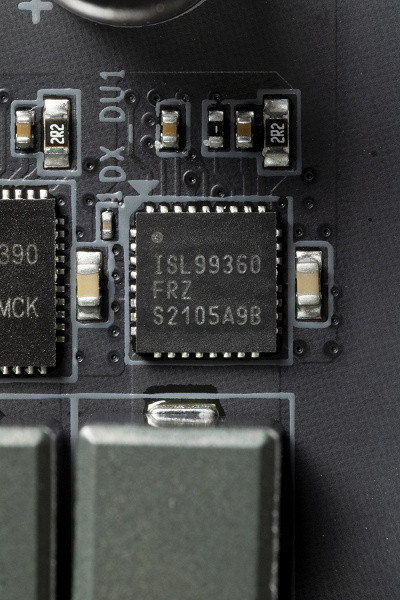
The power supply is controlled by a Renesas RAA229130 PWM controller, which supports up to 20 phases. The manufacturer's website states that the VCore phases operate in an 8+8 configuration, which means that two phases are controlled in parallel at the same time. However, this PWM controller is quite capable of providing full power supply control for both the VCore and the iGPU.
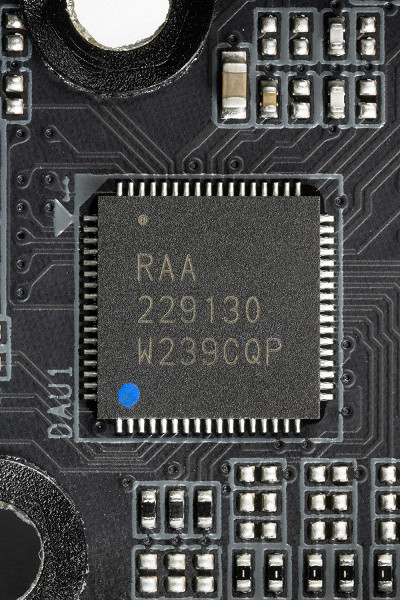
The VCCIO block has its own two-phase power supply circuit (with Om Semi MOSFETs, up to 60 A), controlled by the MP2940A PWM controller (Monolithic Power Systems).
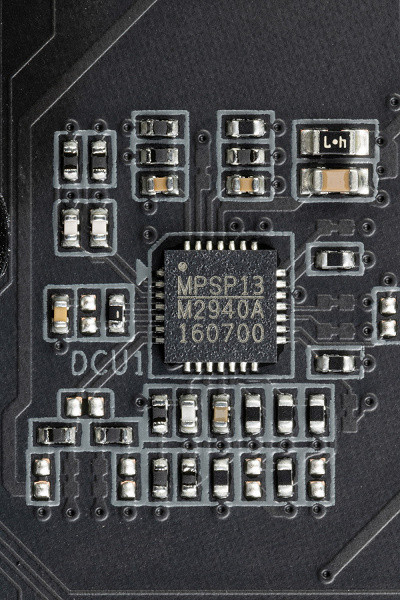
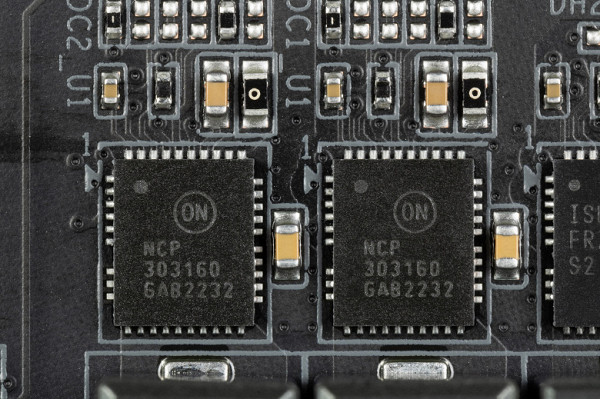
Now about cooling.
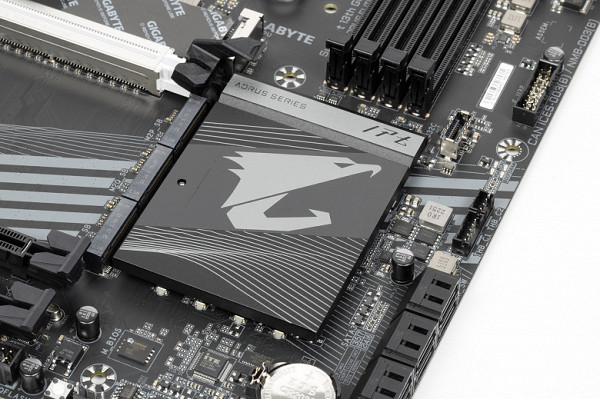
All potentially very hot elements have their own heat sinks.
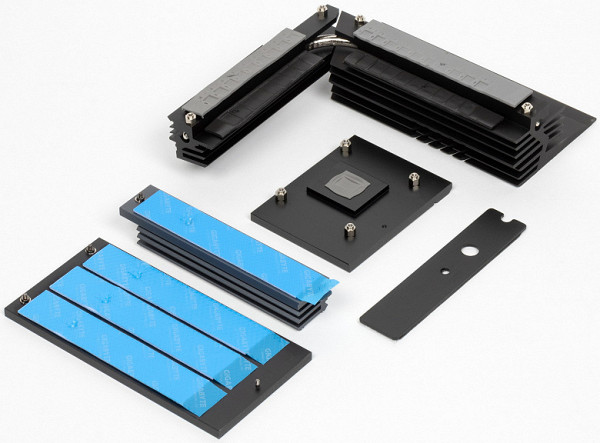
As we can see, the chipset cooling (one radiator) is organized separately from the power converters. The VRM section has its own two radiators, connected by a heat pipe at a right angle.
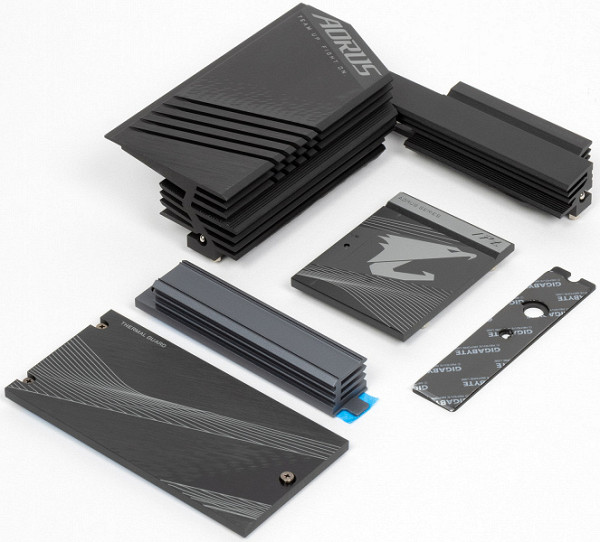
As mentioned, all M.2 slots are equipped with heatsinks: the top slot has a separate heatsink, and the rest have a common one. The motherboard does not have a backplate or a protective plate on the back.
Backlight
The motherboard is equipped with four LEDs placed under the chipset heatsink to create illumination. There are also four connectors for connecting external illumination, which can be controlled through the Gigabyte Control Center program. Some manufacturers of modding cases with built-in illumination certify compatibility with programs of leading motherboard manufacturers, including Gigabyte. If you do not like the illumination, you can disable it through the same program or in the BIOS.
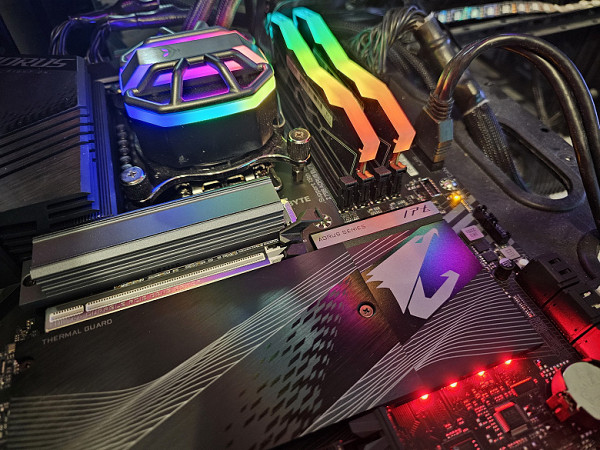
Control is carried out using the RGB Fusion utility already built into the Gigabyte Control Center.
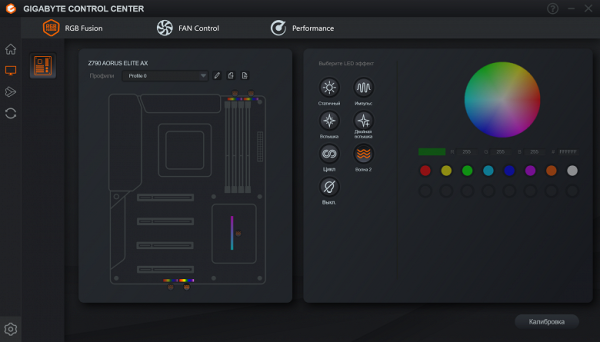
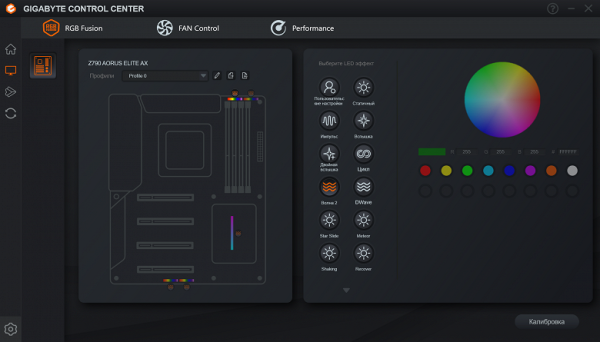
Software for Windows
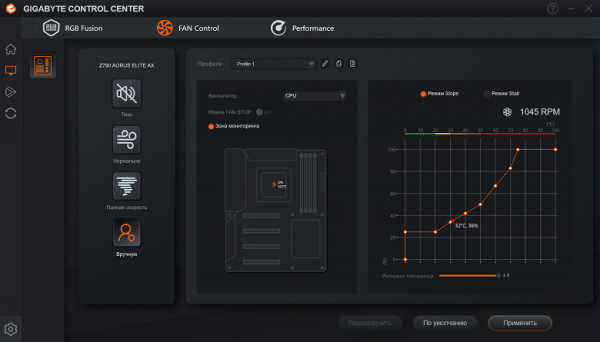
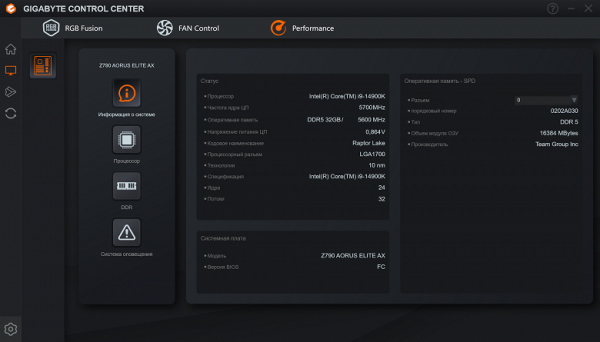
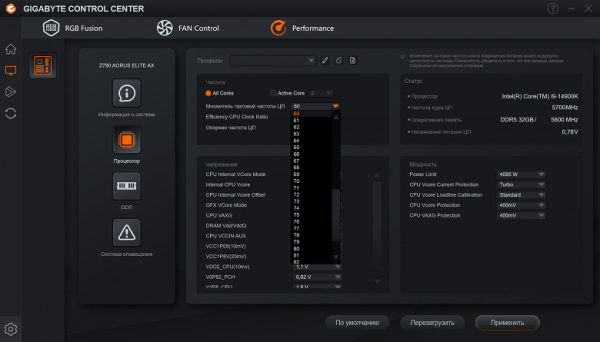
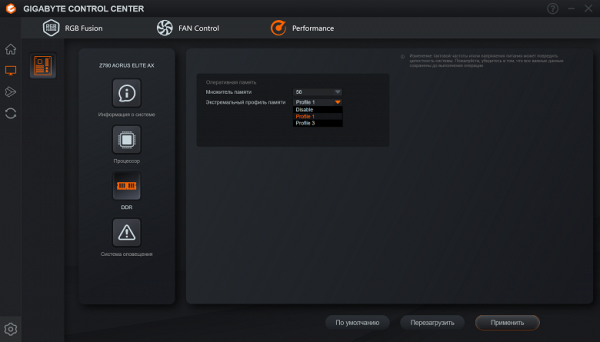
You can configure the board's operation not only by frequencies or voltages, but also regulate the operation of fans, as well as monitor the status of installed SSD drives.
BIOS settings
Modern motherboards are equipped with UEFI (Unified Extensible Firmware Interface), which are essentially miniature operating systems. To access UEFI settings when booting a PC, you usually need to press the Del or F2 key.
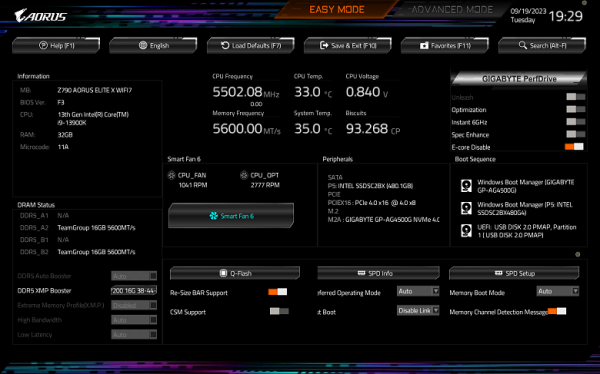
We get to the updated general menu, which has become more functional. Previously, this menu contained mainly only information, but now you can control some functions here without having to go to the «advanced» menu. The latter is intended for more experienced users.
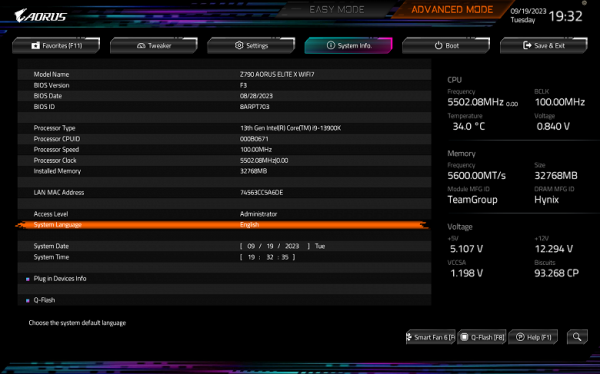
Peripheral management. In this section you can manage everything that the motherboard is equipped with, but not each USB port (apparently, the level of this board is not good enough for such luxury -).
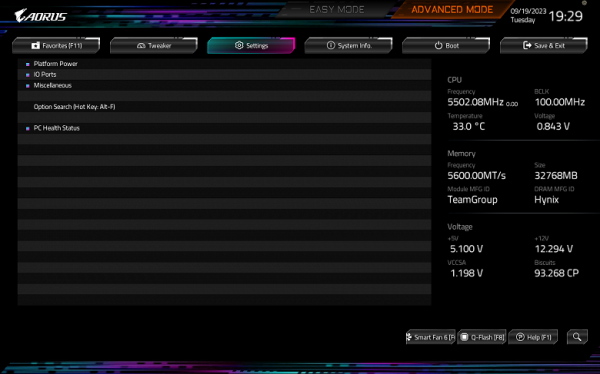
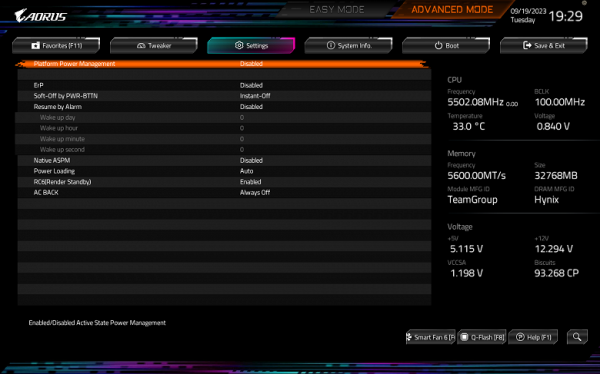
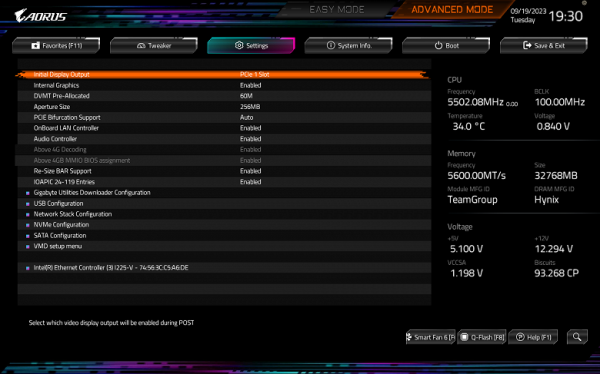
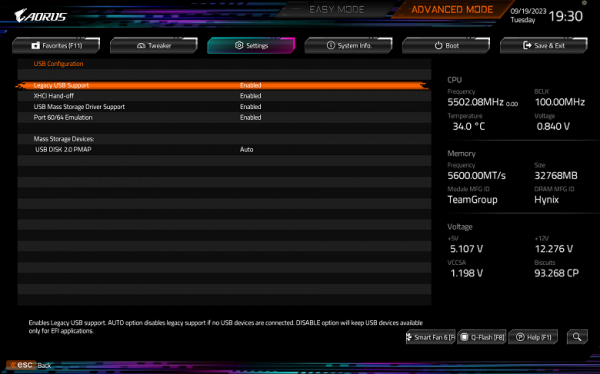
Particular attention should be paid to the section on M.2 and PCIe slot management.
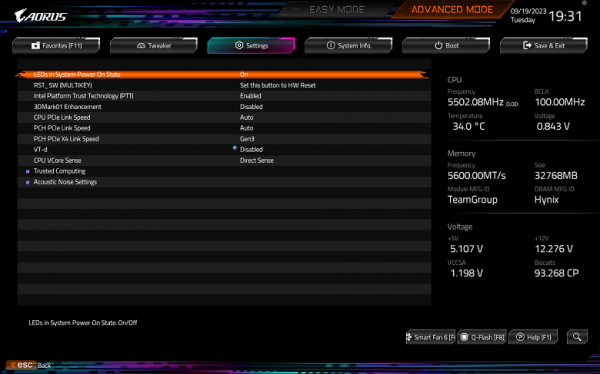
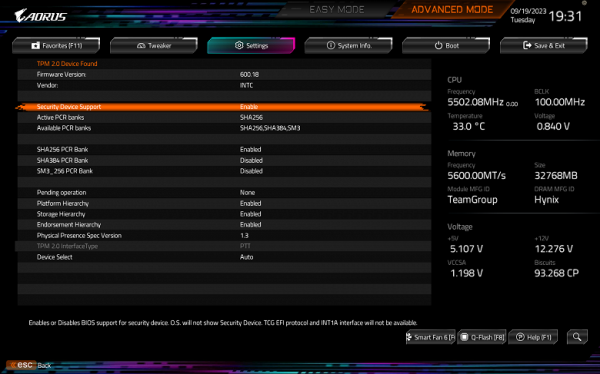
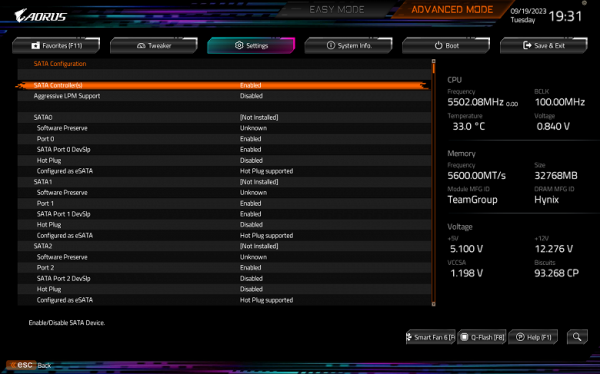
Monitoring and boot menu options are well known to everyone.
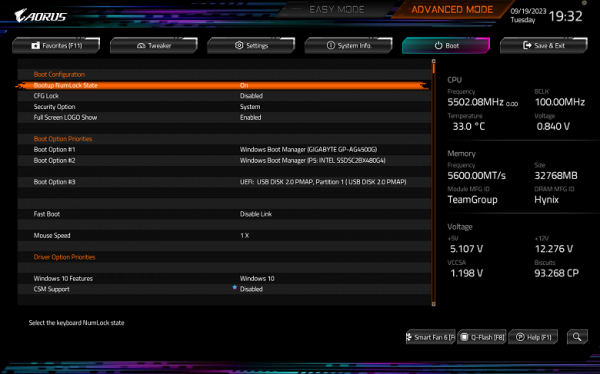
There is also a Smart Fan 6 utility for configuring the operation of fan sockets.
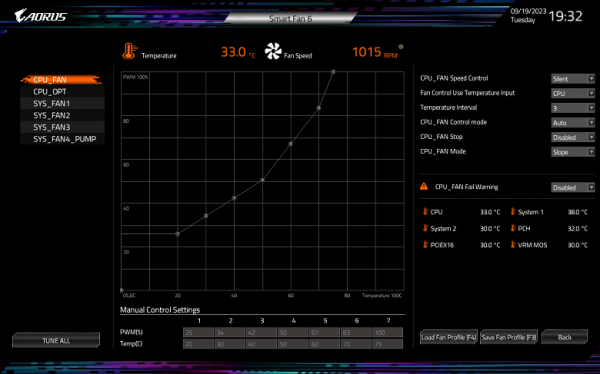
For overclocking, there are essentially already standard options within the framework of what Core processors and DDR5 RAM support.
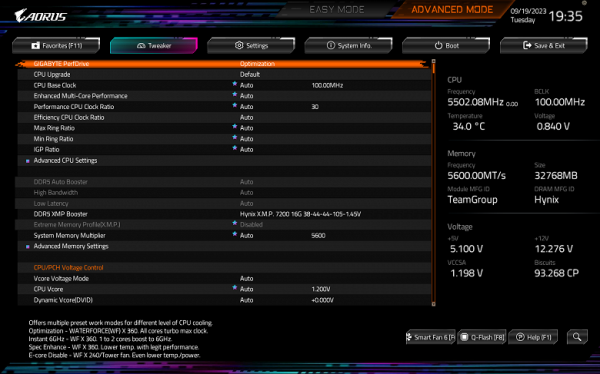
There are few options, which is typical for a mid-budget series. For modern top processors, many of them are unnecessary, since the processors themselves already operate at high frequencies thanks to technologies like Intel TurboBoost.
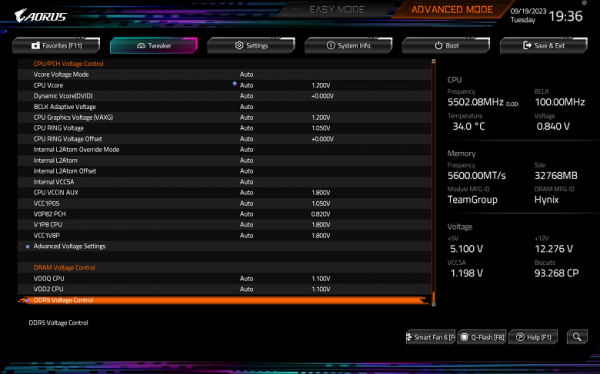
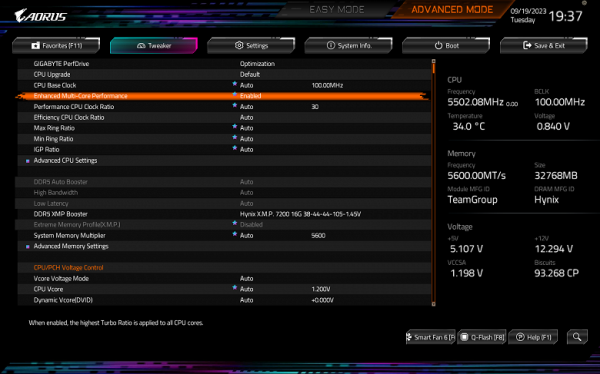
Gigabyte has PerfDrive technology, which intelligently determines the maximum possible frequencies of the processor cores and offers various operating modes. It also allows you to automatically select the optimal frequencies for the installed memory modules.
Performance (and overclocking)
Full configuration of the test system :
- Gigabyte Z790 Aorus Elite AX motherboard;
- processor Intel Core i9-14900K 4.5-5.8 GHz;
- TeamGroup T-Force Delta RGB RAM 32 GB (2×16) DDR5 (CL36-46-46-84) (XMP 7600 MHz);
- TeamGroup MP44L NVMe PCIe 4.0 1TB SSD drive;
- Palit GeForce RTX 3050 StormX graphics card ;
- Power supply Super Flower Leadex Platinum 2000W (2000 W);
- СЖО Sapphire Nitro+ S360-A AIO CPU Cooler ;
- TV LG 55Nano956 (55″ 8K HDR);
- Logitech keyboard and mouse.
Software:
- Operating system Windows 11 Pro, 64-bit
- AIDA 64 Extreme
- 3DMark Time Spy CPU benchmark
- 3DMark Fire Strike Physics benchmark
- 3DMark Night Raid CPU benchmark
- HWInfo64
- OCCT v.13.0.0
- Adobe Premiere CS 2019
We launch everything in the default mode (MCE is in automatic mode). Then we load it with tests. Note that I did not install the BIOS update, where, at Intel's request, automatic overclocking of processors within Intel Turboboost and MCE were disabled.
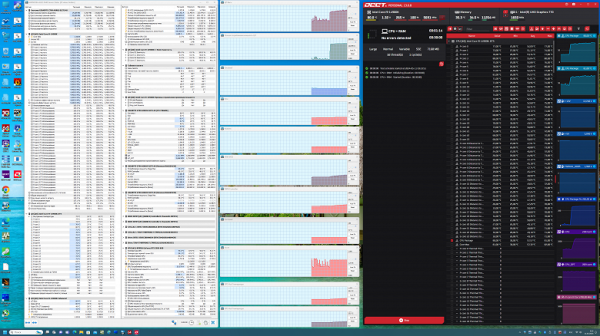
In auto overclocking mode, the processor reached frequencies of up to 5.7 GHz on the P-cores and 4.4 GHz on the E-cores. Let me remind you that the P-cores are high-performance cores with two threads, and the E-cores are energy-efficient, with one thread.
The system, having determined the powerful power supply of the motherboard, set high frequencies by default. All other parameters, including temperatures, were normal. The processor consumption reached 260 W, but there were no instability in operation.
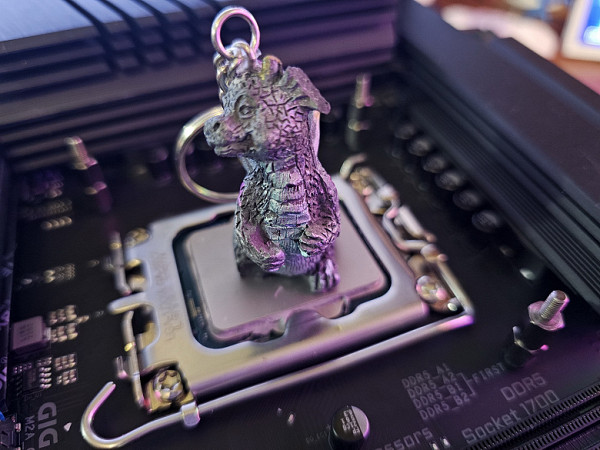
Conclusions
Based on the high-end Intel Z790 chipset, the Gigabyte Z790 Aorus Elite AX motherboard combines top-end specs with a reasonable price — at the time of publication, it starts at $282. The board offers 17 USB ports of various types, including three fast USB 3.2 Gen2 and one USB 3.2 Gen2×2 in Type-C format. It is equipped with three PCIe x16 slots, one of which receives 16 PCIe 5.0 lanes directly from the processor, and the other two operate in x4 mode, connected to the chipset. There are also four M.2 slots: one is connected to the processor via PCIe 4.0, and the other three are connected to the chipset, with the latter sharing resources with two SATA ports. The board offers 6 SATA ports and 6 fan headers. The CPU power system is powerful and capable of supporting overclocking. The board provides effective cooling for all potentially hot components, including M.2 drives. The network capabilities include a fast 2.5 Gbps wired controller and a modern wireless adapter (Wi-Fi 6E + Bluetooth 5.3). Among the advantages, we can note the ability to connect additional lighting via ARGB/RGB connectors.
